Mysteries, Farms, and the Incidents of Dogs in the Nighttime
FARM MYSTERIES
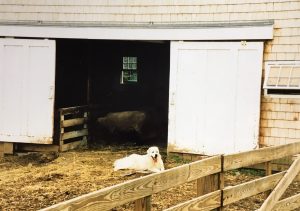
On the Job
Animals went missing. Those were the first mysteries of my life. When I was growing up in rural Maine during the 1960s, dogs and cats were free range to do their jobs. The dogs chased down rabbits and woodchucks, meaning fewer holes in the field to snag cows, ponies, and farm machinery. Cats were feral creatures of the barn and fields, keeping rodents out of the grain. The one time I caught sight of a barn rat from nose to tail I feared for the cats.
Unlike the silent, clue-providing dog in the Sherlock Holmes story, “Silver Blaze,” our farm dogs barked often in the dark of night. They may have been asleep in the kitchen or sheds, yet their ears would prick as raccoons stole into the garden or deer high-footed it into the corn. A single woof, a nail-clicking scrabble to the feet, and then woof-woof-woof until a human woke or the critters scared. Occasionally cows bewitched by the moon decided to take a midnight stroll down the middle of the road that split the farm. Cattle do not properly respect a fence and nose out its trick spots. The dogs’ barking alerted my father, who alerted us. We’d jump from bed in pajamas and tie on sneakers to chase cows into an enclosure.
A solitary bark, and my father would hush the dog. He would stand in the porch shadow and seek the white light sweeping the field. He’d quietly return inside to the rotary phone and call the game warden—deer jackers out and about aiming to shoot a blinded deer. If the light flicked too close, he would jump in the pickup and gun it down the road to scare off jackers before they mistook a Jersey or Guernsey for a deer or gleefully drove through barbed wire to spin ruts into the field
A wandering cow might jump a low gate to be discovered later in a neighbor’s field. The animal would ruminate, her eyes limpid and brown, her string of drool green. As strangers approached, she’d ignore proper bovine behavior to kick her hoofs and run in the wrong direction. A dry cow near her time might hide by the edge of the woods, and I then became a child in a Robert Frost poem “going out to fetch the little calf / That’s standing by the mother.” One or two vanished for good. We never suspected UFOs; the woods were dark and deep.
FERAL CATS
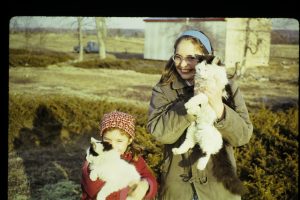
The Self-Domesticated
Cats with their greater numbers disappeared regularly. “Grandmother Cat,” the tabby breeder in the barn, had litters by toms who came and went in the night. Grandmother Cat would not let us touch her, though we could take her milk warm from the cow and pet her kittens. A few offspring chose domestication. This was especially true after a fluffy white house tom went rogue and a Persian blend appeared. One white kitten had a blue eye and a green one, familiar of a good witch. The self-chosen would scoot around an open screen door and dodge my mother’s discouraging foot and “shoo.” They too tended to disappear before reaching old age. Farm equipment would mow them down; distemper would flair up. Cats didn’t warrant vet care when rural folk could scarcely afford health care for themselves. There was a rabies scare—blame the raccoons. The state health department clamped down on the required dog vaccination and enlisted farm families and volunteers to catch cats and restrain them in onion bags. Vets could inoculate the yowlers right through the netting. Nothing’s as fast as a cat let out of a bag.
DOGS FOUND AND LOST
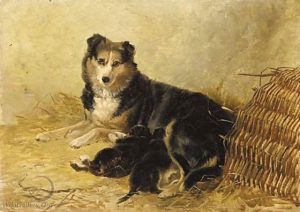
The Scot Original by Richard Ansdell
While farm dogs had the lazy habit of sleeping by the fire, on the doorstep, in the middle of the road, our prime mutt was swift—the mistress of the acreage, Wags. My father brought her home from another farm, and he had bundled her in his Dickies’ jacket (now called an Eisenhower because of its military style). A Border collie-mutt mix, she was an adorable brown, white, and caramel puppy. She liked being petted and sleeping on beds, but never cared to learn tricks and never tolerated a collar over her white ruff. (Her ID tags were stuck with family papers in the buffet drawer and tarnished with the silver.) Adult Wags answered to her jobs before she answered to us children. She patrolled the fields, scared off other dogs, gave strangers an evil eye. She answered to assignments of her own making. She bore litters of puppies because, in mother’s opinion at the time, spaying made females fat and lazy, and in the farm economy dogs were to be passed around. Few would pay for a dog, no normal person would pay for a cat. We gave the puppies away, mostly. There was “Vixen,” a fawn-colored pup who resembled the fox in a Dr. Doolittle illustration (we had my father’s old copies of the Hugh Lofting books). She played more than Wags and got along fine with her dam. Once my mother screamed at them when a doe bounded into the garden and the dogs took after her pell-mell through pasture and into woods. Dogs could be shot on sight for hounding deer to their death. Deer were rare then, and rarely seen because of prowling dogs had not yet overpopulated the suburbs in search of good schools. A trivia point: Maine fawns were the models for Disney’s Bambi. Our dogs did not kill any of Bambi’s friends that day and returned in ten minutes, unbloodied and unabashed.
During hay season when we were out in the trucks gathering bales, the dogs would follow and then chase down a scent. One evening Vixen, about two years old then, didn’t return for supper. Wags showed up near midnight, her coat a mat of burs. Vixen—she’ll come back, my mother said.
She didn’t. All of us looked and called whenever we went out into the fields for weeks, for months.
Wags had another litter of puppies. She had been penned when “in heat,” but the clever beast escaped. Her pups’ first food beyond mother’s milk was Pablum. Wags also brought her babies gory woodchucks, which they eschewed for the Pablum and playing with us. We kept a black curly-haired puppy, Trixie. I may have named her after Trixie Belden, the “girl detective” in the book series. Trixie, sweet and submissive, became my younger sister’s dog. In several years’ time, she disappeared as well. It was late March with spring uncertain about its estimated time of arrival. The woods had caches of snow, while the fields were muddy hillocks. I was fourteen and could walk the roads and check the ditches. I probed as far into the overgrown woods as I dared. The Maine woods had been logged generation after generation to become dense thickets of pines, tamaracks, birch stands, brush, and wild raspberry canes over old felled trees. Bogs spread here and there. Not penetrable.
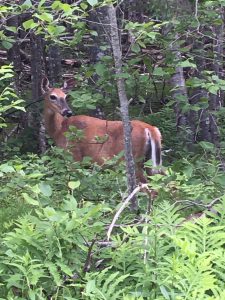
Bambi’s sweetheart
We never found Trixie. I had suspicions. Had Wags lost her daughter-rivals on purpose? Was this canine treachery and betrayal? By that time, spaying had become routine and Trixie had gone under the knife, which my mother suspected damaged her instincts. (Do spay and neuter—no dog deserves to be unwanted and abandoned!) My mother also said people set traps for muskrats and maybe, what a shame, our pet had been trapped. My father said Certain People shoot strange dogs on sight—not a comfort. If Trixie had been hit by a truck, farm machinery, fox or other dogs may have hauled the carcass into the woods. My investigation ended, and green returned to the fields and new growth shadowed the woods more than ever.
When I was in my senior year of high school, aging Wags changed. She became terrified of thunderstorms and tried to dig her way through the cracked linoleum in the kitchen. She, who never cared to play, adopted squeaky toys from our babyhood—a rubbery pig, a soft plastic kitten. Wags dug a hole under an abandoned chicken coop and hid pig and kitten as if they were her puppies. She killed one last woodchuck for them, which I had to haul away before it stank up the farm yard.
We never learned what happened to Vixen and Trixie. On a hot August afternoon, stashing hay away in the barn loft, we tripped over Grandmother cat, older than I was. She lay dried and dead where she had borne her kittens. Ancient Wags developed a cancerous tumor and was euthanized when my sister and I were in college. People dumped dogs on my parents: an Irish Setter gone mad with inbreeding; an epileptic Saint Bernard who had to be euthanized because in a fit his powerful jaws might clamp on an arm; another Saint Bernard, Barrie, who begged for more attention that my bone-tired parents could give. After Barrie’s death, my parents were dogless. Until a mutt, German shepherd in the blend, showed up in the farmyard. Just hanging, threatening no one. My mother couldn’t stand the idea of not feeding him and called him Stray. Stray made himself welcome with his benign presence. When my father began to decline with Parkinson’s, he took pleasure in laying his heavy hand on Stray’s head.
Stray of unknown origins—the calmest dog the farm had known—would spend his warty dotage inside by the woodstove. As for the longest-lived, Wags and Grandmother Cat, they survived the nighttime. They kept their secrets. They were mysteries to us.
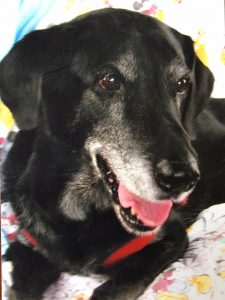
Farm dogs don’t have Mickey Mouse blankies.
Beautiful writing.